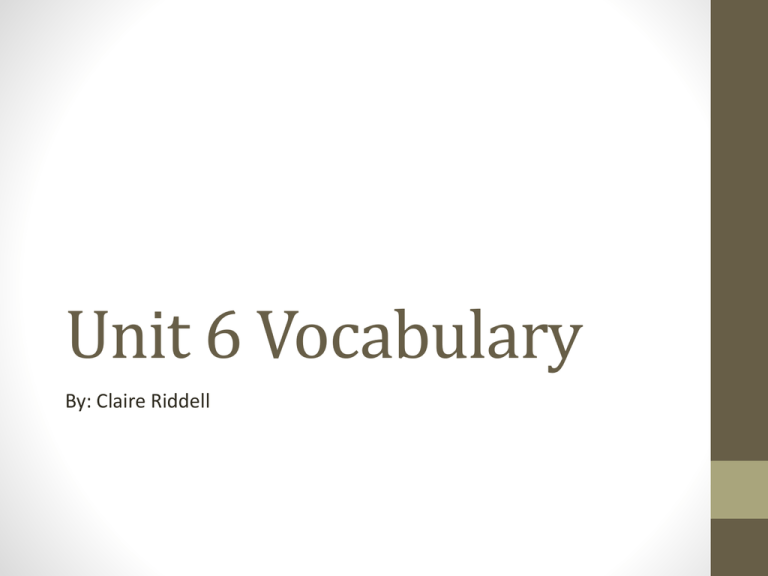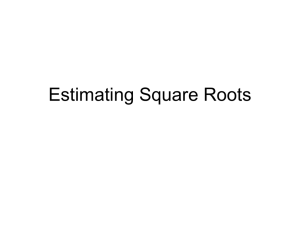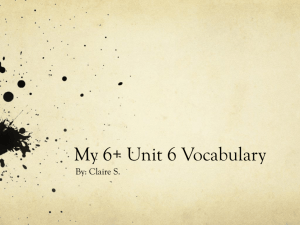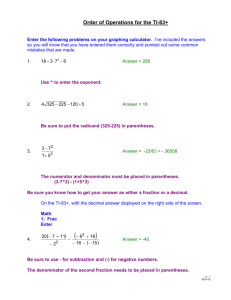Unit 6 Vocabulary
advertisement

Unit 6 Vocabulary By: Claire Riddell Constant Term • A constant term is a large amount that stays the same and does not change. Division of fractions property • A fact that says, when you divide a fraction, it is equivalent to the reciprocal of the fraction, that is multiplied. Equation A number sentence that has an equal sign in it. Example: 5 = 3 + 2 Example: 14 = 7 + 7 Equivalent Equations • Different equations that have the exact same solution to the problem. • Example: 5 + y = 7 and 6 + y = 8 y=2 Both of the equations have 2 for the solution. Example: 8 – z = 5 and 19 – z = 16 z=3 Both of the equations have 3 for the solution. Inequality • A sentence that uses the ≤, ≥, >, <, = or ≠ • Example: 45 > 31 • Example: 5 < 23 Integers • An integer is a number or a negative number that is in the set of, (-4, -3, -2, -1, 0, 1, 2, 3, 4) Example: -3 is an integer Example: 0 is an integer Multiplication property of -1 • A property that is in multiplication, that says, z (-1) that is multiplied by z, equals the opposite of z. • Example: 5 * (-1) = -5 • Example: 3 * (-1) = -3 Nested parentheses • Nested parentheses is a set of parentheses in one set, inside another set of parentheses. • Example: ((5*2) + 1) • Example: ((8 + 4) * 1 + 9) Open sentence • A sentence which is not true, and not false because one or more variables, takes the place of the missing numbers. • Example: 9 + a = 12 • Example: 3 + z = 10 Opposite of a number • An opposite of a number can be a positive or a negative number, depending on the number. • Example: The opposite of 5, would be -5 • Example: The opposite of -1, would be 1 Order of operations • Rules that show how to do operations, in order. • Example: The first rule is, always do the numbers with parentheses first. • Example: The third rule is, divide or multiply, from left to right. Reciprocal • Also is called multiplicative inverse. Two fractions or numbers, which there product is one. • Example: the Reciprocal of 5/6 is 6/5 • Example: The Reciprocal of 1/3 is 3/1 Relation symbol • A symbol that shows relationship between two amounts. • Example: = means its equal to a number. • Example: > means its greater than a number. Repeating Decimals • A repeating decimal is a decimal, when multiplied or divided, equals to a decimal that keeps repeating itself. • Example: .3333333 is a repeating decimal. • Example: .888888888 is a repeating decimal. Solution • A part in a number model that makes the model true. • Example: 2 + z = 10. 8 is the solution to this set • Example: 5 + a = 7. 2 is the solution to this set Solution Sets • A set of all the solutions of an equation. • Example: The solution set of X₂ = 64 is 8 • Example: The solution set of A₃ = 8 is 2 Terminating decimals • A decimal that always ends. • Example: 0.2 is a terminating decimal • Example: 0.12 is a terminating decimal Trial and error Method • Trial and error method is a method that teaches you from your mistakes, as you try again and again until you get the problem right. • Example: Timmy tried the equation (((2 * 5) +8) /2) = Z At first, Timmy thought the answer was 40, then 1 because he multiplied or divided it wrong. Then Timmy saw it clearly, and figured out that the answer was 9. • Example: Alec had to do an equation: (5 to the power of 3) +5 = A First, he thought the answer was 20, because he did (5 * 3) + 5 = 20 instead of 5 to the power of 3. He kept trying 3 more times, then figured out the mistake and found out the answer was really 130. Variable • A variable is a letter that can substitute a number in a number sentence or an equation. • Example: 2 * A = 8 • Example: 5 + Z = 7




